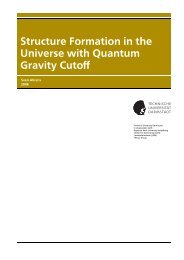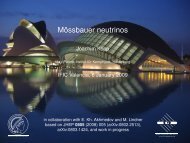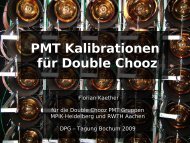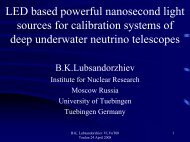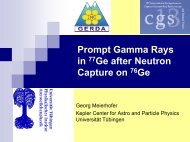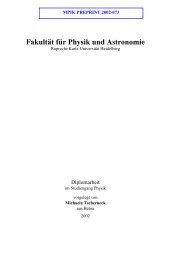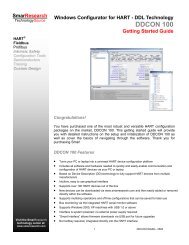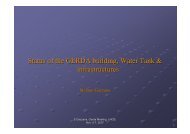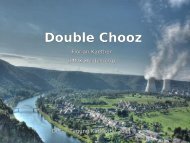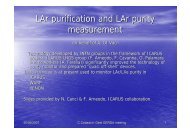Natural convection in enclosures with localized heating from below ...
Natural convection in enclosures with localized heating from below ...
Natural convection in enclosures with localized heating from below ...
Create successful ePaper yourself
Turn your PDF publications into a flip-book with our unique Google optimized e-Paper software.
have addressed natural <strong>convection</strong> <strong>in</strong> <strong>enclosures</strong> due to either a horizontally or<br />
vertically imposed temperature difference. However, departures <strong>from</strong> this basic<br />
situation are often encountered <strong>in</strong> such fields as the electronics cool<strong>in</strong>g. The<br />
cool<strong>in</strong>g of electronic components is essential for their reliable operation.<br />
<strong>Natural</strong> <strong>convection</strong> cool<strong>in</strong>g has been widely used because of its simplicity, low<br />
cost and reliability (Incropera, 1988; Peterson and Ortega, 1990; Kim and Lee,<br />
1996).<br />
Torrance et al. (1969) experimentally and Torrance and Rockett (1969)<br />
numerically studied the <strong>convection</strong> of air <strong>in</strong> a vertical cyl<strong>in</strong>drical enclosure,<br />
<strong>in</strong>duced by a small hot spot centrally located on the floor. Solutions were<br />
obta<strong>in</strong>ed for Grashof numbers <strong>from</strong> 4 10 4 to 4 10 10 . The theoretical results<br />
were found to be <strong>in</strong> an excellent agreement <strong>with</strong> the experimental ones <strong>in</strong> the<br />
lam<strong>in</strong>ar region. Chu et al. (1976) studied, both theoretically and experimentally,<br />
the effect of the size and location of an isothermal, horizontal strip <strong>in</strong> an<br />
otherwise <strong>in</strong>sulated vertical surface of a rectangular channel. For a similar<br />
cavity, Turner and Flack (1980) made an experimental study. The natural<br />
<strong>convection</strong> <strong>in</strong> an <strong>in</strong>cl<strong>in</strong>ed box <strong>with</strong> the half of the lower surface heated and the<br />
other half <strong>in</strong>sulated was <strong>in</strong>vestigated experimentally and numerically by Chao<br />
et al. (1983). The effects of elevation of the heated and <strong>in</strong>sulated segments were<br />
<strong>in</strong>vestigated, as well as of <strong>in</strong>cl<strong>in</strong>ation about the longer dimension. An<br />
experimental <strong>in</strong>vestigation was conducted by Kamotani et al. (1983) to study<br />
natural <strong>convection</strong> heat trasnfer <strong>in</strong> a water layer <strong>with</strong> <strong>localized</strong> heat<strong>in</strong>g <strong>from</strong><br />
<strong>below</strong>. The flows were driven by ma<strong>in</strong>ta<strong>in</strong><strong>in</strong>g a small circular heat source, at a<br />
uniform temperature. The flow structures and temperature fields were<br />
<strong>in</strong>vestigated <strong>in</strong> detail for various aspect ratios (depth/width) and Grashof<br />
numbers Gr. Steady natural <strong>convection</strong> <strong>in</strong> a square, water-filled enclosure<br />
heated <strong>from</strong> <strong>below</strong> and cooled on one vertical side is studied analytically and<br />
numerically by November and Nansteel (1987). Keyhani et al. (1988)<br />
<strong>in</strong>vestigated, both numerically and experimentally, natural <strong>convection</strong> <strong>in</strong> a<br />
vertical cavity <strong>with</strong> one isothermal vertical cold wall and three alternatively<br />
adiabatic and flush-heated sections of equal height on the opposite wall. A<br />
numerical <strong>in</strong>vestigation of natural <strong>convection</strong> of air <strong>in</strong> square cavities <strong>with</strong> halfactive<br />
and half-<strong>in</strong>sulated vertical wall was made by Valencia and Frederick<br />
(1989). An experimental and numerical study was made by Chu and Hichox<br />
(1990) for natural <strong>convection</strong> <strong>in</strong> an enclosure <strong>with</strong> <strong>localized</strong> heat<strong>in</strong>g <strong>from</strong> <strong>below</strong><br />
<strong>in</strong> order to simulate the convective transport <strong>in</strong> a magma chamber. The large<br />
viscosity variation characteristics of magma <strong>convection</strong> was simulated by<br />
us<strong>in</strong>g corn syrup as the work<strong>in</strong>g fluid. Hasnaoui et al. (1992) numerically<br />
<strong>in</strong>vestigated natural <strong>convection</strong> <strong>in</strong> an enclosure <strong>with</strong> <strong>localized</strong> heat<strong>in</strong>g <strong>from</strong><br />
<strong>below</strong>. The upper surface was cooled at a constant temperature and a portion of<br />
the bottom surface was isothermally heated while the rest of the bottom surface<br />
and vertical walls were adiabatic. The existence of multiple steady-state<br />
solutions and the oscillatory behavior for a given set of the govern<strong>in</strong>g<br />
parameters were demonstrated. Ganzorolli and Milanez (1995) numerically<br />
<strong>Natural</strong><br />
<strong>convection</strong> <strong>in</strong><br />
<strong>enclosures</strong><br />
519



